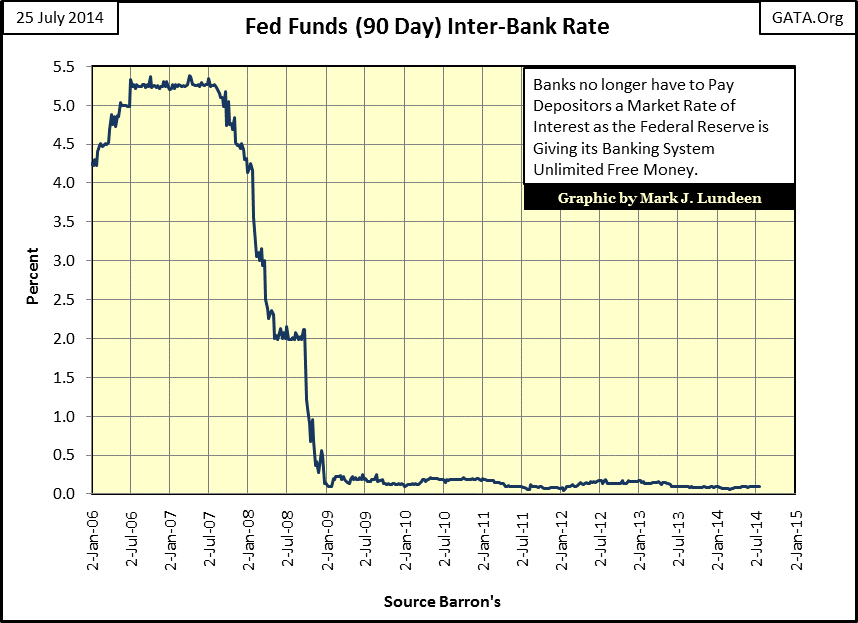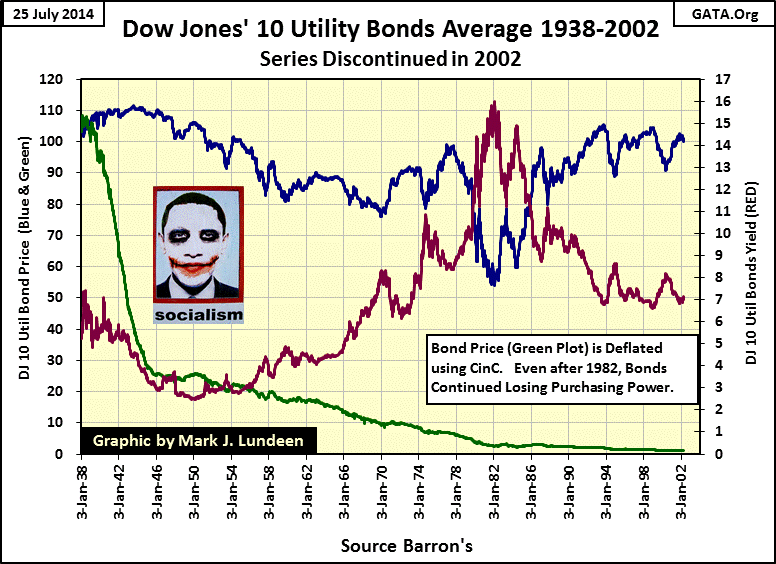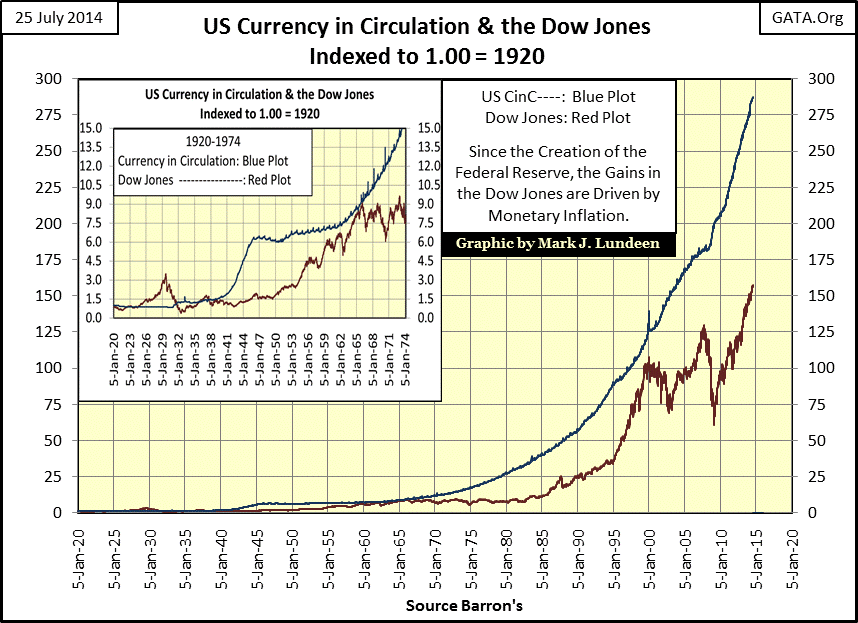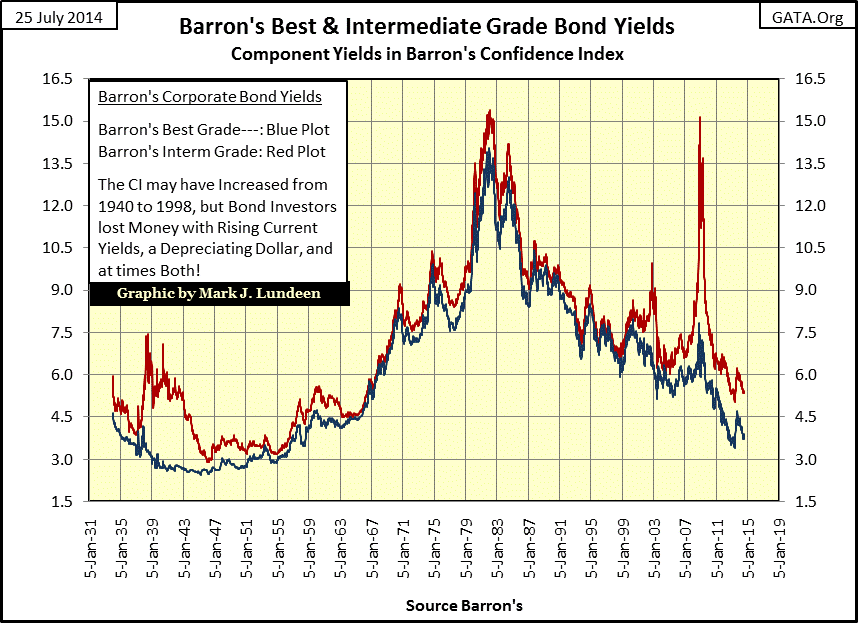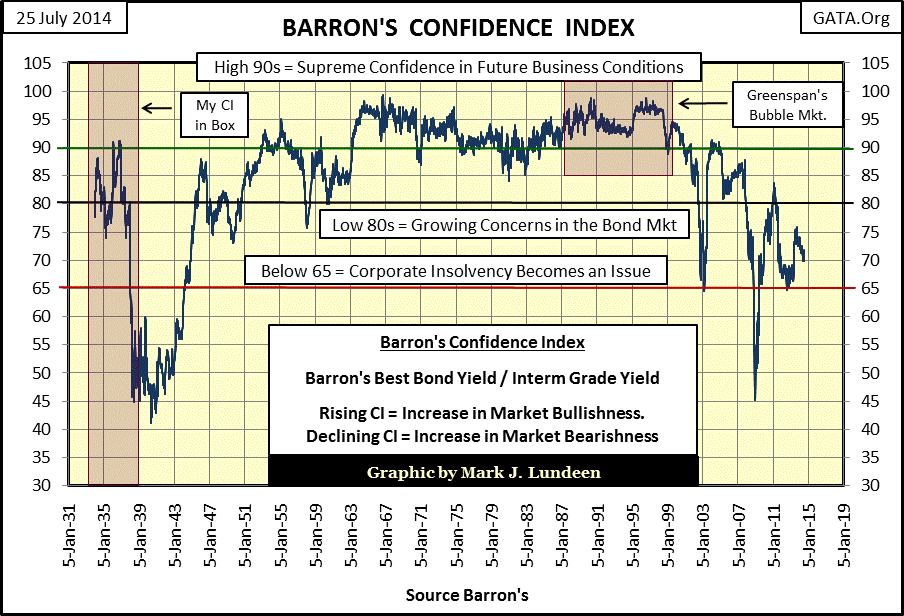The Federal Reserve Bad – Gold And Silver Good
I have some good news and some bad news this week; first the bad news. The “policy makers” dictating “monetary policy” at the Federal Reserve have decided that in order to save the banking system from its scandalous behavior over the past four decades, it’s now necessary that grandma receive only 0.15% on her savings at the bank. The good news? She still intends to vote for Roosevelt this November.
Some may not see the humor in my good news, but sadly, in all too many instances it’s true. Occasionally I see political commentators remark that Wall Street has a natural enemy in President Obama, but in fact President Obama is the best friend Wall Street has had since Franklyn Delano Roosevelt (FDR) became president. Just like FDR in 1933, Obama came to office in 2009 with the Federal Reserve and its banking system suffering from near fatal self-inflicted wounds. If FDR or Obama had really wanted to clean up Wall Street by eliminating the Federal Reserve and its ability to counterfeit US dollars they both had the perfect opportunity to do so, but both chose to leave the fox in the hen house.
The public in 1933, as in 2009, was ready to support honest reform in the financial markets. In March 2009 Obama’s attorney general Eric Holder needed no new legislation from the Congress to charge Wall Street with fraud. How hard would it have been to have prosecuted and convict the management of Wall Street for selling bogus interest-rate derivative contracts? Not hard at all, but that didn’t happen! One of the first decisions made by the Obama administration in 2009 was to protect the banks that had sold hundreds of trillions of dollars of these worthless derivatives to insurance companies, pension & mutual funds and foreign sovereign investment funds. Instead of prosecuting these criminals President Obama chose to bail out Wall Street with taxpayer money and look the other way as the Federal Reserve extended a $12 trillion line of credit to European banks, a sum that (at the time) was larger than the entire $10.8 trillion dollar US national debt.
For services rendered, the Clintons become centimillionaires after leaving office by giving honorarium speeches in empty auditoriums at Wall Street banks and to middle-eastern dictatorships. I expect the Obamas will prosper just as much, possibly more after they exit the White House. Call it “social justice.”
The latest financing scandal by the Federal Reserve is 21st Century Fox’s Rupert Murdock’s bid to purchase Time Warner for $80 billion. Geeze Louise, the market cap for entire NYSE in March 1938 was only $31.8 billion. (source Barron’s) In 1938 the NYSE had just over a thousand companies trading on its floor and $31.8 billion could have purchased them all: the entire industrial and commercial base of the United States! Trust me; today a billion dollars doesn’t buy anywhere near what it once did for the simple reason that Washington’s entrenched political class created their engine-of-inflation – the Federal Reserve – one hundred years ago.
Now whenever I watch the mainstream news I do watch the Fox News Channel. However I know that Fox’s management will never cover the financial markets as I would have them do simply because if they did their bankers would never deliver the $80 billion to acquire Time Warner! Like every corporation whose shares trade on the NYSE, Fox get its financing from the big Wall Street banks that ultimately are funded by monetary inflation flowing from the Federal Reserve. The $80 billion Mr. Murdock hopes his banker will deliver to him will in one way or another originate from the Federal Reserve, as this is where all dollars come from. I suspect Mr. Murdock doesn’t lose much sleep thinking about it, as in 2014 that’s how big business works.
This ability to create dollars in unlimited quantities at little or no cost has allowed the Federal Reserve to in effect buy up the American media via proxies like Rupert Murdock. And it’s not just the media that the Federal Reserve has purchased. Its pernicious influence is seen in generous contributions to politicians, like your congressman and senators who expect to receive election year campaign funding from Wall Street.
“In congressional races in 2010, the candidate who spent the most won 85 percent of the House races and 83 percent of the Senate races, according to the Center for Responsive Politics. Indeed, the percentage for 2010 was lower than it had been in recent election cycles. The center found that in 2008, the biggest spenders won 93 percent of House races and 86 percent of Senate races. In 2006, the top spenders won 94 percent of House races and 73 percent of Senate races. And in 2004, 98 percent of House seats went to candidates who spent the most, as did 88 percent of Senate seats.”
- Tampa Bay Times
Higher education has received over a trillion dollars via the school loan program. Had the banking system not funded these school loans, the price of a college education would still be affordable. The same is true for the price of housing. In hindsight, five decades after Washington severed the dollar’s connection to gold, those who Washington had intended to help, ultimately suffered great financial harm when politicians legislated assistance programs funded with subsidized low interest loans, and guaranteed by the Federal government. All too many college students today find themselves trapped in a similar situation as the farmers of the Great Depression era; too much debt with no market opportunity to pay it back.
But that’s the strategy of the central bank; trap the debtor, a farmer in this case with debt that cannot be repaid, and foreclose on the farm. In the case of student debt there is no collateral to repossess. However in 2005 Congress, in its wisdom passed the Bankruptcy Abuse Prevention and Consumer Protection Act, requiring student-loan borrowers “to file an “adversary proceeding”—a type of lawsuit within a bankruptcy case—to prove “undue hardship” in order to get their loans forgiven”. “In normal bankruptcy proceedings, student loans are nondischargeable.”
Source: The American Prospect January 23, 2013
No doubt the fact that a bankrupt student can afford the services of a lawyer to file an “adversary proceeding” is prima facie evidence that they have the means to service their school loans.
Here is a snippet from the US Senator; John Sherman (Brother to Civil War General; William Tecumseh Sherman), who sponsored the National Banking Act of 1863.
"The few who can understand the system (An American Central Bank) will either be so interested in its profits, or so dependent on its favors, that there will be no opposition from that class, while on the other hand, the great body of the people, mentally incapable of comprehending the tremendous advantages that capital derives from the system, will bear its burdens without complaint and perhaps without even suspecting that the system is inimical to their interests."
- John Sherman, protégé of the Rothschild banking family, in a letter sent in 1863 to New York Bankers, Morton, and Gould, in support of the then proposed National Banking Act.
So much for trusting that the “Best and the Brightest” will work for the welfare of the nation. President Andrew Jackson had the right idea in 1832:
“You are a den of vipers and thieves. I intend to rout you out, and by the eternal God, I will rout you out! ...”
- President Andrew Jackson: To a delegation of bankers discussing the Bank Renewal Bill of 1832
At first thought, it seems odd that in a world drowning in dollars personal thrift would be so poorly rewarded. Look at table below; today $100,000 returns a mere $150 per annum in a savings account. A five year CD isn’t much better, with substantial penalties for early withdrawal.
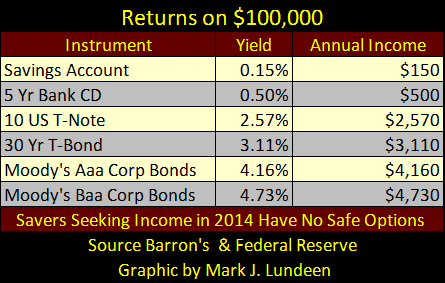
The banking problem grandma can’t get around is that since January 2009 the American banking system has been offered * UNLIMITED FUNDING * from the Federal Reserve for less than 0.20% (chart below). Since June of last year, the Fed Funds rate has been below 0.10%. With “monetary policy” like this, bankers have absolutely no need to bid for deposits from savers; and so they don’t. Retirees who saved a percentage of their wages their entire lives so they wouldn’t be a burden to their families or society, have been thrown to the wolves by the “policy makers” in Washington and Wall Street. And certainly no media outlet wanting $80 billion from Wall Street to purchase a competitor would ever protest. I’m not picking on Fox. Whether they know it or not the legacy networks like CBS and the NY Times are captives of the Federal Reserve System as well.
As intended by Doctor Bernanke, and now Janet Yellen, people in need of monthly income have been forced into the bond market (table above). A large percentage of retail investors are totally ignorant of the inherent dangers to principal invested in the bond market which currently returns nowhere near its historical (or near term) average yield. Below is a chart for the discontinued Dow Jones 10 Utility Bond Average.
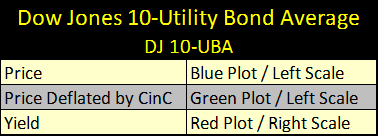
Because of the predictable nature of the utility industry, these bonds were one of the safest investments available during the Great Depression. But over the next seven decades, holders of these bonds discovered that buying fixed income investments in an inflationary monetary system is a mug’s game. One can do superb monetary archeology by watching old movies and TV programs. In the gangster movies from the 1930s, Humphrey Bogart wanted out of the rackets as soon as he came up with his “10 Gs” ($10,000). Below George Burns informs us why in 1957 retired people could no longer get by on $120 a month ($1,440 annually).
“The real problem with retiring is money. Most people save their whole lives to retire in the same style they enjoyed when they were working, only to realize that they can’t live like they used to even while they’re still working. You see these ads for retirement and they always have fishing boats in the background. That is because for $120 a month, fishing is the only way retired people can feed themselves.
- George Burns: George Burns and Gracie Allen Show Season 8 Episode 9, 1957
Someone receiving a 2.50% return on a utility bond purchased in 1950 never saw an increase in their annual fixed income payment ($25 a year on a $1000 investment) as interest rates soared to over 16% thirty years later ($160 a year on a $1000 investment). They would also discover that the market value of their bond principal had declined substantially in an economy suffering double digit consumer price inflation. Although they could still get the full $1000 back from the bond issuer by holding it until maturity, its purchasing power was far less after three decades of Fed money printing.
Take a moment and study my next table; the values are as published in contemporary issues of Barron’s. From January 1938 to April 2002, the percentage increases in monetary inflation (CinC) were 1300% greater than the gains in the Dow Jones. But looking at the DJ 10-UBA, even though it recouped most of its losses from 1981, after sixty-four years it was still down $1.50 from its 1938 price, a 1.45% decline.
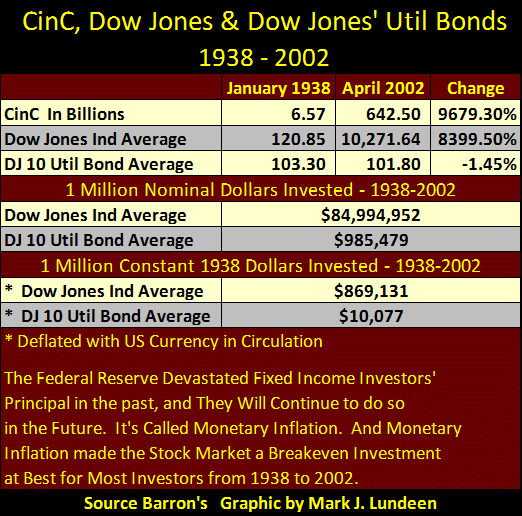
To put scale to the devastating decline in purchasing power suffered by bond investors from 1938 to 2002, let’s compare the DJ 10-UBA to the Dow Jones in nominal dollar terms from 1938 to 2002 in the table’s next section. A million dollars in 1938 afforded its owner a Manhattan penthouse suite and the income sufficient to fund a millionaire’s lifestyle, say $30,000 a year. But whether the good times would last for the next seven decades depended upon whether the millionaire invested in stocks or bonds. A million dollars invested in the Dow Jones (Red Plot below) may not have kept up with increases in CinC (Blue Plot), but seeing a million 1938 dollars in dividend yielding blue-chip stocks appreciate to $85 million dollars in April 2002 (a bear market year) was a fantastic return compared to the $14,521 loss if invested in the DJ 10-Util Bond Average over the same period.
The fact is that a million dollars invested in the DJ 10-UBA was a 1938 millionaire’s ticket to the working class. In 2002, interest income from $985,479 no longer funded an opulent lifestyle as it had sixty-four years earlier.
The table’s last section shows the sixty-four year performance for the Dow Jones and the DJ 10-UBA in constant 1938 dollars. In 2002, the DJ 10-UBA recouped most of its nominal dollar losses from the 1950-1981 bond bear market. But in constant 1938 dollar terms (1938 purchasing power), the bond investor had lost 99% of their wealth to the banking system and their supporters in Washington via the ever expanding money supply flowing from the Federal Reserve.
The real problem with bonds is that they’re a relic of the gold standard, an anachronism that for investors serves no purpose in our world of unrelenting monetary inflation. Below are the plots of the component yields used in Barron’s Confidence Index (CI); these yields are from bonds rated investment grade. Bear markets are seen as rising bond yields, bull markets in falling yields. If bond market history has one lesson to teach investors, it’s that buying bonds when yields are low is a mistake. Currently, yields for investment grade bonds are at levels not seen since the 1960s. Unfortunately, to retired people choosing between 0.15% offered for their savings at the bank or 5.50% from an “investment grade” bond (Red Plot below), the bond market today is deceptively enticing.
But today’s bond market has real problems. I may be the only market commentator today who regularly publishes Barron’s Confidence Index (CI), but I’m glad to do it as the CI has been an excellent forecaster of future economic conditions since the 1930s. It’s important to understand that the CI is not a bond market timing tool. In fact it’s a horrible tool for timing the bond market. The CI increased during most of the 1950-81 bond bear market, and declined during the 2000-2014 bond bull market. So, what good is it?
Significantly, the CI gives us the bond market’s appraisal of the ability of issuers of lesser quality investment grade bonds to service their debts to term. Since 1999, the bond market, (as seen by Barron’s CI), has an increasingly maligned view of American bond issuers’ ability to service their debts to term – and for good reason.
In early July David Stockman, President Reagan’s former budget director called the five trillion dollar corporate bond market “the IEDs of monetary central planning that will soon be exploding along Wall Street.” Here few snippets of what he said:
“So we have basically a highly artificial one-way market in corporate bonds—both investment grade and high yield. Very recently yields in the latter touched an all-time low of 4.87%, meaning that after inflation and taxes there is virtually no room for losses on securities that are called “junk bonds” for a reason. Likewise, the investment grade index yield is down to 2.97%, leaving almost no margin for risk relative to the allegedly risk free rate on treasuries.” ---
--- “But the Fed has now taken financial repression to such an extreme that it has caused the corporate bond market to triple in size, even as Dodd-Frank has resulted in a considerable shrinkage of dealer inventories and market liquidity. Accordingly, the exits will be jammed like never before when the corporate bond self-off inexorably arrives. The speed and violence of the impending re-pricing is only hinted at by the thundering collapse of securitized mortgages that occurred in the fall of 2008.”
Let’s look closely at Mr. Stockman’s last sentence; “The speed and violence of the impending re-pricing is only hinted at by the thundering collapse of securitized mortgages that occurred in the fall of 2008.” In 2008 the securitized mortgage market was a liquid multi-trillion dollar market that became a no-bid market and remains so today. If he is correct, and I expect time will prove he is, the five-trillion dollar corporate bond market, like the market for mortgage backed securities would disappear over the course of a few months, as bond yields soar far above their highs of 1981. The stock market will not be immune from a disaster in the bond market as many listed companies trading on nation’s stock exchanges will also be deeply involved in the coming bond market debacle.
As I’ve noted many times before; gold and silver * DO NOT * benefit from monetary inflation, financial assets like stocks, bonds and real estate do. Gold and silver, as well as other precious metals and mining shares benefit from deflating financial assets. As people once again flee from deflation, they will seek the safety of investments in gold and silver. With many trillions of dollars, euros, and yen bidding for the limited supply of market available gold and silver, don’t be surprised when the precious metals markets become no offer markets. In a world where ivy-league academics control the volume of credit and money circulating in our economy, it would be unwise to expect a positive outcome. Gold, silver and the depressed precious-metal miners never looked so good.






